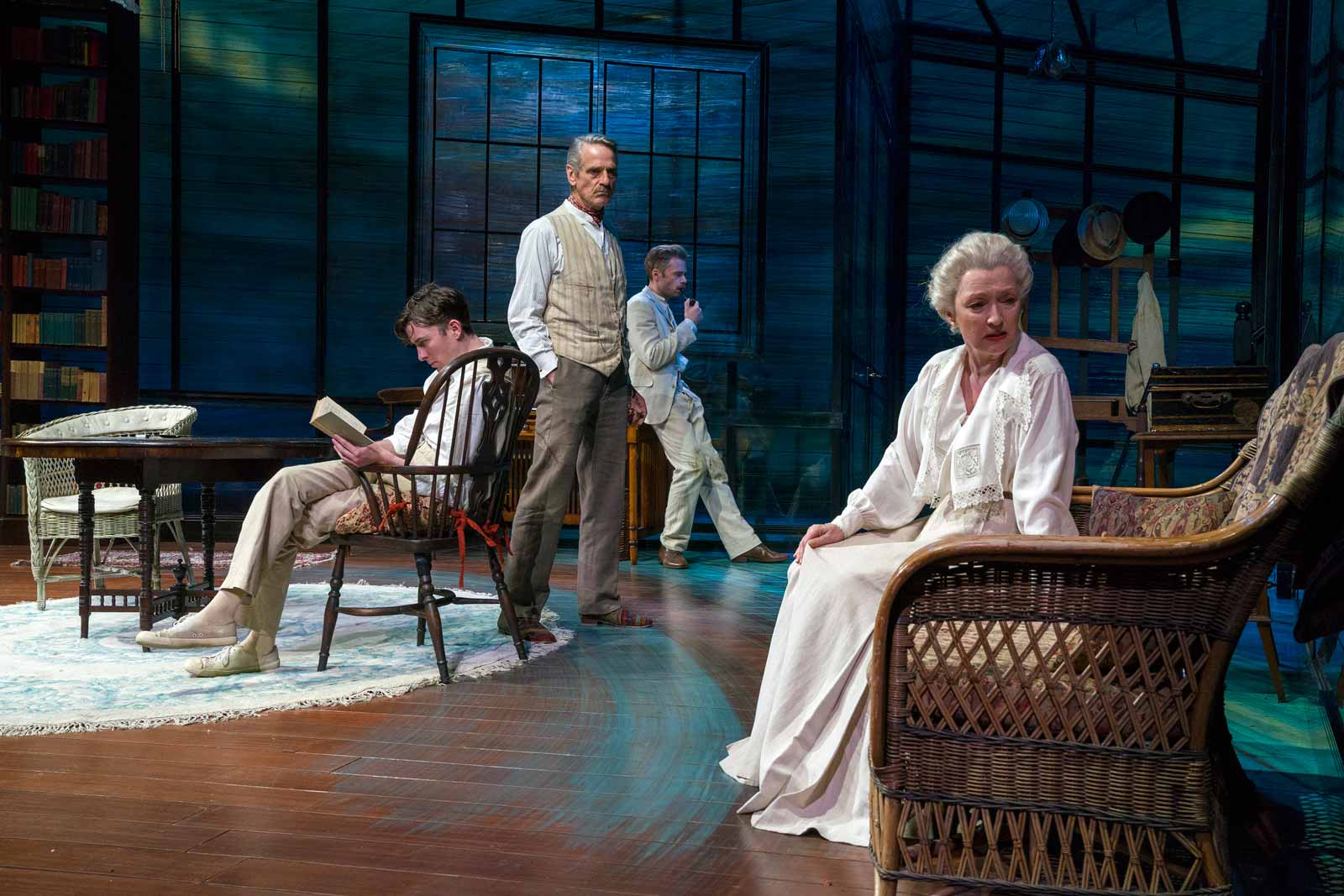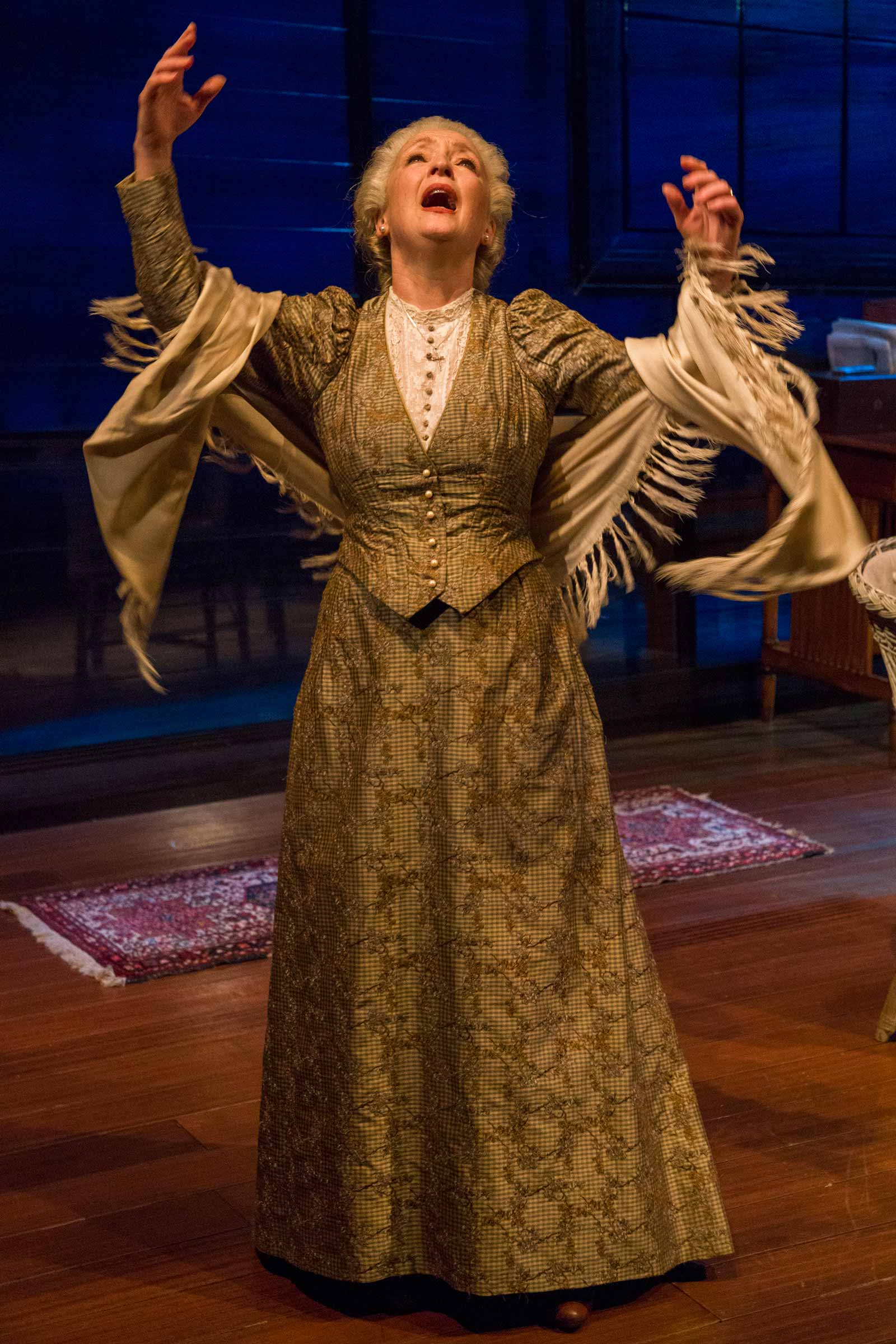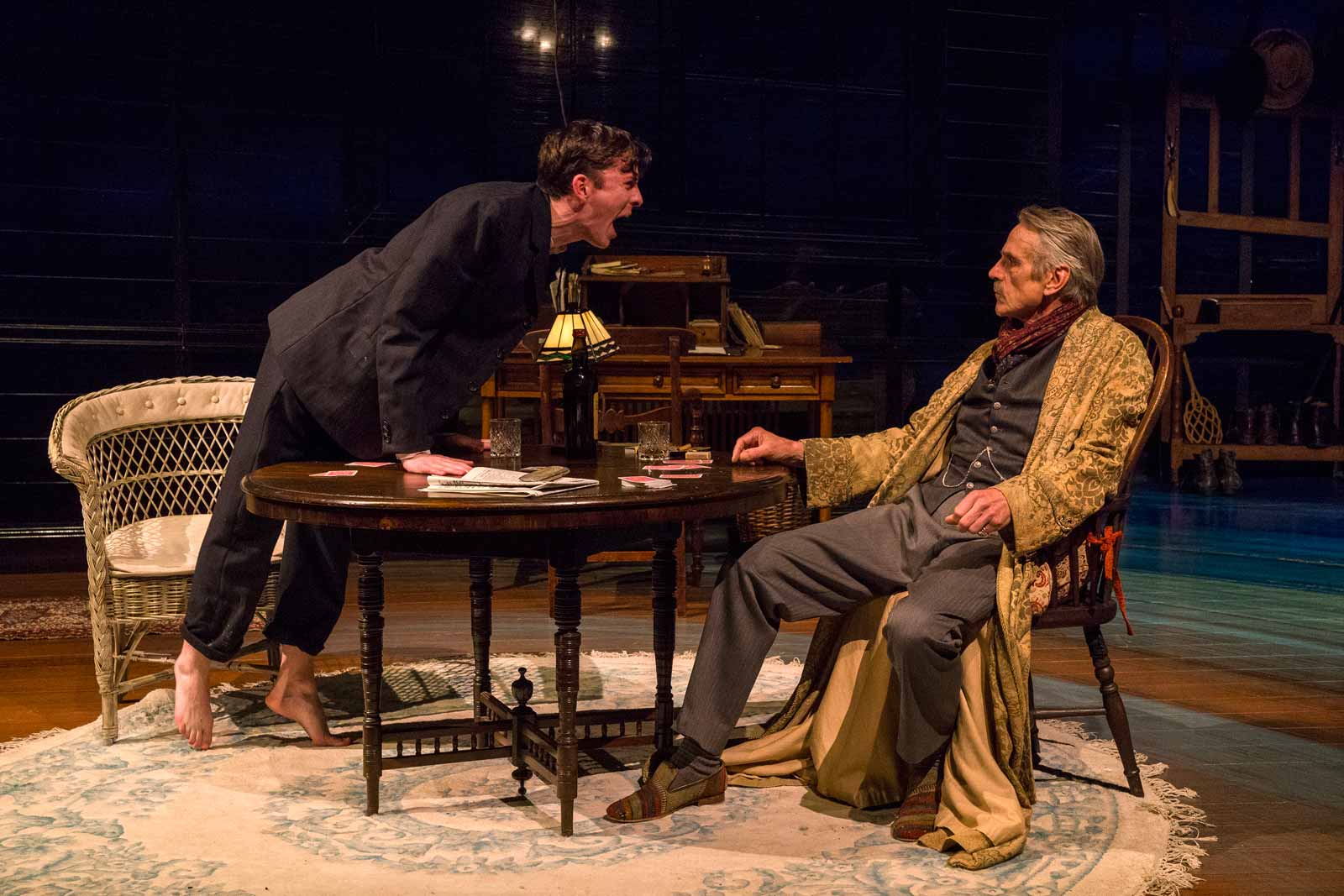For the first stretch of the opening-night performance of Richard Eyre’s Bristol Old Vic production of Long Day’s Journey into Night at BAM, I had the uneasy sense that things might have been jumpstarted at too rapid a clip. The impression may have owed something to the annoying habit indulged by some theatergoers of applauding celebrity actors (in this case, Jeremy Irons and Lesley Manville) when they make their first entrance, even if it means drowning out the opening line of a most delicately calibrated play. Irons retrieved matters by quickly repeating the line, but there did seem something a little wrong-footed in the way the dialogue between the two raced along from then on, not allowing for even a hint of apparent domestic calm before things started spinning out of control.
There is, after all, only one moment of rest in the play: before anything has happened. The initial moment—when James Tyrone (Irons), using all his actorly charm to compliment his wife Mary (Manville) on what “a fine armful” she has become while she was away, can still believe, or pretend to believe, that things are back to normal, and that Mary has been cured of her drug habit at the sanatorium she has just returned from—is so brief as barely to register. The façade will begin promptly to erode—nothing is brought to our attention except as it falls apart—and when their sons Jamie (Rory Keenan) and Edmund (Matthew Beard) come into the room they will join the process by which every form of reassurance will be chipped away by evasion or contradiction or direct attack. Here at BAM, that process kicked off at a headlong pitch that at first felt uneasily rushed.
Ultimately, as the wider arc of Lesley Manville’s performance became apparent, the unease made sense. The rattled breathlessness of her delivery, as if half a second’s interruption would bring everything crashing down, established the state of things in the Tyrone household with no delay: the masks are already off. Manville’s Mary is not merely distracted but positively a junkie with screaming nerves, turning her head from side to side almost spasmodically, not knowing what to say or do from one second to the next, her words tearing along like a runaway train. Her speediness pulls the rest of them along, struggling to keep pace with her and revealing at once that none of them is in control.
Even more than usual, in this production Mary is the center around which the rest move in denial, sometimes pausing to confront her in brief outbursts of anger or pleading, or turning away as if in the hope she might disappear. The extent to which these three men live in fear of her is manifest in the cowering dread with which, in the last act, they listen to her footsteps pacing in the upstairs bedroom. Mary inherits the ultimate curse of solitude—she is the only one ever alone on stage, and even speaks a few lines of soliloquy—and Manville comes into her own triumphantly in the final two acts, as Mary becomes the creator of her own theater of memory, a play within a play for which she becomes all the characters and is the only audience. In the heart of solitary delusion, she becomes the being she truly is, the being that flakes off into fragments in her dealings with others.
Tempo is crucial since O’Neill is so essentially a musical writer. Robert Falls, who directed a bracing production of The Iceman Cometh at BAM three years ago, has remarked of him: “He’s writing a score.” If Iceman is an orchestral work for some twenty voices, rising often into busy ensemble passages, Long Day’s Journey into Night is his supreme chamber piece. The four chief instruments—James Tyrone and Mary and Jamie and Edmund—are sharply differentiated whether sparring in duets or quartets or launching into extended solos. (The fifth voice, that of their maid Cathleen, played by Jessica Regan, is injected into the middle of the play as a brief tonal respite, comic and oblivious, to break up an otherwise inexorably gathering heaviness.)
To think of these characters as instruments rather than agents goes to the heart of the play. For all the reiterated talk of “willpower”—specifically with regard to Mary’s morphine addiction, yet pointing also to the mens’ habitual drunkenness, Tyrone’s obsessive parsimony, Jamie’s self-lacerating pessimism—everything shows them deprived of any real liberty, even enough liberty to keep from saying the same things uselessly, again and again, in conversations that connect only fitfully before subsiding into postures of resentment and hopelessness. The family dysfunction of which Long Day’s Journey is the classic portrait is embodied in a music of violent stasis, in which forces of attraction and repulsion toggle perpetually back and forth. However isolated each voice, the echoes of the others are always hanging in the air around it, all of them inextricably tied together no matter how stubbornly they tug to pull free.
Advertisement
In Eyre’s production, the protagonists circle continually around one another, occasionally lurching into violent contact, sometimes attempting affectionate overtures that are quickly curtailed. Early on, there is a good deal of energetically overlapping dialogue, and it is only gradually that each of the actors emerges fully. Irons is a lean Tyrone tightly wound within himself, with only a hint of the grandiloquence of the theatrical idol. (Irons certainly brings a persuasive note to his portrayal of a popular star who has reached the stage of burnt-out reflectiveness.) Even his flare-ups of patriarchal wrath when egged on by Jamie or Edmund are half-hearted, scenes, one senses, that have been played many times too often. If Mary is a force of chaos set loose in the household, the senior Tyrone is the principle of order reduced to a melancholy but formally correct stance.
Rory Keenan’s Jamie has the right mix of wiseguy humor and bitter contempt, and in his final drunk tirade manages to strip away any trace of empathetic feeling; while Matthew Beard, as Edmund, more than holds his own in a part that can sometimes seem the play’s weakest link. As a stand-in for O’Neill, the consumptive Edmund hovers on the periphery, more observer than participant. The others figure as what they irrevocably are, but he is not yet realized, and thus not altogether doomed. As Beard plays him, Edmund is very much the writer in embryo, restlessly roving around the room, never without the safety valve of a book in hand. In his cups, he turns his speeches into literary sketches. The monologue about his transcendent experience at sea of seeing “the veil of things as they seem drawn back by an unseen hand” can seem endless and mawkish, but here it plays as an ambitious young poet self-consciously trying out his powers of invention, showing off for his father, half-exhilarated and half-depressed at the results.
Narrative is of little account in Long Day’s Journey; the tale is almost blurted out in order to get at what matters. This is, after all, as close as O’Neill could have gotten to putting his early life on stage. The painful secrets revealed are his own. It is not a play about family, but family fully realized as a play. The underlying rhythm is of a ritual whose phases are preordained, a ritual of progressive and exhausting exposure. What has been set in motion must continue long past the point of any reasonable hope—in fact, to a point of bone-weariness—and yet the production radiates an energy close to ecstasy: a sorrow not enervating but vital. It is a work that mercilessly tests each actor’s ability to inhabit roles that are not characters but beings, summoned by an authorial process that can only be conceived as an occult attempt to restore speech to the dead.
The sense of exhaustion is accentuated by those diabolical patterns of repetition that were O’Neill’s fundamental device. For some readers and playgoers, his repetitions are a flaw and a mark of stylized implausibility, sometimes eliciting nervous laughter. Stylized they may be—his theatrical mode is always expressionist at its core—yet they mark the seam where his sense of music and his sense of brute reality are joined. To diagram any of his plays by the frequency and arrangement of its repetitions, of words and behavior and the recurrence of memories, would be to define its essential shape. The bits and clumps of language his people grab at—“snoring” and “fog” and “quack” and “summer cold” and “willpower” and “morbid” and “cheap hotels” and “it’s a good man’s failing”—are turned around, tossed back and forth, questioned, and seized on as a last resort. If the Tyrones scarcely pause to search for a word, it is because they are condemned to repeat what they have said a thousand times before. In between the repeated words are the repeated sounds: the foghorn, Mary’s pacing footsteps, the comforting gurgle of whiskey poured into a glass.
Advertisement
Rob Howell’s set design gives us a sense of skewed perspective. The left side of the stage is dominated by an impressive ceiling-high bookcase with the matched sets of classics of which O’Neill writes in a stage direction: “The astonishing thing about these sets is that all the volumes have the look of having been read and reread.” The foreground has the minimal elements of a 1912 interior, some chairs, a couch, and the table where the booze is poured: this tentative space is where the family makes its gestures toward being a family. But the room’s timelessly abstract wall slants inward, its angle suggesting an arctic bareness in the house’s inner reaches, the jail-like abstraction of what, for Mary, can never be a home. As the characters back toward its various exits and passageways, each can duck toward some offstage escape hatch, whether the upstairs bedroom where Mary takes her morphine or the tavern where the men take their comfort. The world outside the room is invisible, and the lighting translates the foggy overcast weather into a darkness that sets in long before night falls.
That the prominence of the bookcase is not a casual touch comes to the fore in the last act, with its long passages of poetic declamation. The Tyrones are a literary family not by comfortable habit but for dear life. The autodidact James Tyrone has saved himself by literature, with dreams of becoming a great Shakespearean actor, and at the same time has betrayed literature by succumbing to the easy money of a popular melodramatic success. His life has been a matter of reciting words written by others; the alcoholic Jamie has the talent and the talk of a writer, but is incapable of being one; and Edmund, book in hand, has not yet become the writer he needs to be to avoid self-destruction. His only redemption will be the very play we have been watching, the play he has in extremis been able to write.
When Tyrone and Edmund confront each other in the last act, their weapons are Shakespeare on the one hand and Dowson and Baudelaire on the other. (The present production underscores this battle by expanding the passage from The Tempest recited by Tyrone, and Irons uses this to display at once the sincerity of Tyrone’s craft—his recitation is not a matter of bombastic bluff—and the impairment of his ability to summon up the lines.) Jamie’s belated drunken return is punctuated by recitations of Rossetti and Swinburne, a reminder that Edmund will never be entirely free of his brother’s influence. And as Mary, now terminally lost in memory, makes her final entrance, Jamie is given the play’s bitterest and most surefire laugh line—“The Mad Scene. Enter Ophelia!”—as if to certify that it has all been a play, but one from which the characters are unable to exit.
Eugene O’Neill’s Long Day’s Journey Into Night is at the Brooklyn Academy of Music through May 27.





